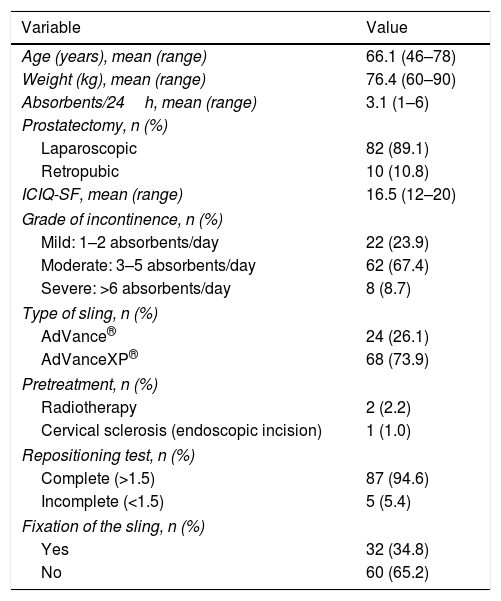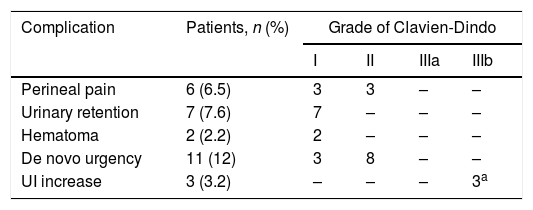To analyze the safety, efficacy and quality of life of patients with male stress urinary incontinence after radical prostatectomy treated with the AdVance® and AdvanceXP® slings.
Patients and methodThe study included 92 patients with stress urinary incontinence after radical prostatectomy treated with the AdVance® and AdVanceXP® sling between May 2008 and December 2015. A perineal repositioning test was performed in all cases with sphincter coaptation of ≥1.5cm. Mild stress urinary incontinence was defined as the use of 1–2 absorbers/24h; moderate was defined as 3–5 absorbers/24h; and severe was defined as more than 5 absorbers/24h. Healing was defined as the total absence of using pads; improvement was defined as a reduction >50% in the number of pads; and failure was defined as a reduction <50, no improvement or worsened incontinence. Check-ups were conducted at 3, 12 and 36 months after the surgery. We employed the International Consultation on Incontinence Questionnaire-Short Form (ICIQ-SF) for the quality of life index. The complications are listed according to the Clavien-Dindo classification.
ResultsThe degree of preoperative incontinence was mild in 23.9%, moderate in 67.4% and severe in 8.7% of the patients. The mean use of preoperative pads was 3.1 (range 1–6, 95% CI). The mean preoperative ICIQ-SF score was 16.5 (15–20). Sphincter coaptation ≥1.5cm using the perineal repositioning test was present in 87 patients (94.6%). The mean follow-up from insertion of the sling was 42.1 months. Some 89.1% of the patients were healed at 3 months, 70.7% were healed at 12 months, and 70.4% were healed at 36 months. The ICIQ-SF score at 3, 12 and 36 months showed significant improvement (p<0.001) compared with the preoperative score.
ConclusionsThe Advance® and AdvanceXP® system are effective over time in terms of urinary continence and patient satisfaction.
Analizar la seguridad, la eficacia y la calidad de vida del paciente con incontinencia urinaria de esfuerzo masculina tras una prostatectomía radical, tratados con el cabestrillo AdVance® y AdvanceXP®.
Pacientes y métodoSe han incluido en el estudio 92 pacientes con incontinencia urinaria de esfuerzo tras una prostatectomía radical tratados mediante cabestrillo AdVance® y AdVanceXP® entre mayo de 2008 y diciembre de 2015. Se realizó en todos los casos test de reposición perineal con coaptación esfinteriana≥1,5cm. Se definió incontinencia urinaria de esfuerzo leve como el uso de 1-2 absorbentes/24h; moderada: 3-5 absorbentes/24h, y grave más de 5 absorbentes/24h. Como curación se definió la ausencia total de uso de absorbentes, mejoría cuando la reducción fue mayor del 50% en el número de estos y fracaso cuando la reducción fue menor del 50%, no se obtuvo mejoría o se produjo un empeoramiento de la incontinencia. Se realizaron controles a los 3, 12 y 36 meses tras la cirugía. El índice de calidad de vida utilizado fue el International Consultation on Incontinence Questionnaire-Short Form (ICIQ-SF). Las complicaciones se reflejaron según la clasificación de Clavien-Dindo.
ResultadosEl grado de incontinencia preoperatoria fue de tipo leve en el 23,9%, moderada en el 67,4% y grave en el 8,7%. El uso medio de absorbentes preoperatorio fue de 3,1 (rango 1-6, IC 95%). La puntuación media preoperatoria del test ICIQ-SF fue de 16,5 (15-20). La coaptación esfinteriana≥1,5cm mediante el test de reposicionamiento perineal estaba presente en 87 pacientes (94,6%). El seguimiento medio desde la inserción del cabestrillo fue de 42,1 meses. El porcentaje de pacientes curados a los 3 meses fue del 89,1%, a los 12 meses del 70,7% y a los 36 meses del 70,4%. La puntuación del ICQ-SF a los 3, 12 y 36 meses mostró una mejoría significativa (p<0,001) respecto a la puntuación preoperatoria.
ConclusionesLos sistemas Advance® y AdvanceXP® se muestran eficaces en el tiempo en cuanto a la continencia urinaria y la satisfacción del paciente.












